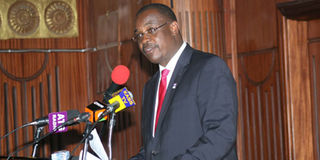Counties go for debts in budget plans

Dr Evans Kidero, the Nairobi governor, speaks during the county’s first stakeholders conference at Charter Hall, Nairobi. Photo/FILE
What you need to know:
- Nairobi County unveiled a Sh31.5 billion budget with the hope of raising Sh14.6 billion from internal sources while Sh16.9 billion will be catered for by transfers from the National Treasury.
- Treasury officials said that no particular model was sent to counties to guide in the preparation of the budgets.
A tug of war looms over the funding of counties after governors tabled budget estimates with huge financing gaps in the hope that the national government will allow them to borrow to plug the shortfall.
Mombasa County has unveiled Sh22.3 billion budget estimates for 2013/2014. Out of this, Sh13.9 billion — or 62.3 per cent of the budget — is unfunded. Presenting the estimates, Mombasa governor Ali Hassan Joho, noted that he would be seeking loans from development banks and donors to fill the shortfall.
This will require approval by the national government. Given the current debt level, almost hitting 50 per cent of the country’s wealth, such approval may not be forthcoming.
The National Treasury is under pressure to reduce the country’s debt ratio to a more manageable level.
Treasury officials who spoke on condition of anonymity said that almost all counties have prepared deficit budgets with the assumption that the national government will approve all their alternative sources of funding ranging from domestic to international borrowing.
The Constitution provides that counties can only borrow funds after seeking approval from the Ministry of Finance since the government must guarantee all loans taken on behalf of the public.
Nairobi County unveiled a Sh31.5 billion budget with the hope of raising Sh14.6 billion from internal sources while Sh16.9 billion will be catered for by transfers from the National Treasury.
But Nairobi governor Evans Kidero admitted that “the traditional sources of funding from which the defunct City Council relied on to raise revenues have proved inadequate and unreliable.”
This means that much of the internal funding may fall short, leaving the council with no alternative except to borrow.
The governor has already laid out a plan to borrow money from international lenders such as the World Bank and also issue municipal bonds to repay outstanding loans totaling Sh33 billion that have accumulated over the years.
In Nakuru, the county government tabled a budget of Sh9 billion in the 2013/2014 with a surplus of more than Sh550 million.
“The surplus Sh550 million will form the core of the citizens’ project identification process as a constitutional requirement,” Nakuru governor Kinuthia Mbugua said when he tabled his estimates.
The tabling of the estimates, whose deadline is today, takes place even as the national government admitted that it failed to guide county treasuries on budget making.
Treasury officials said that no particular model was sent to counties to guide in the preparation of the budgets. Under the transition clause, the National Treasury was mandated to help county government set up treasuries and even second staff to help build capacity. However, this was held back after the fallout witnessed when the central government hired county commissioners.
“In fact, even the ministries have been reduced from 42 to 18 but there are no corresponding adjustments as to the budgeting process. What is going to be there is double budgeting,” said one official.
Under the Constitution, a minimum of 15 per cent of the revenue collected by the national government must be shared out among the 47 counties.
Through the Division of Revenue Act 2012, the National Treasury indicated that the shareable revenue in the 2013/14 financial year will be Sh945.5 billion. Out of this, Sh198.7 billion will be shared in the next financial year, with Nairobi taking the lion’s share at Sh15 billion.




